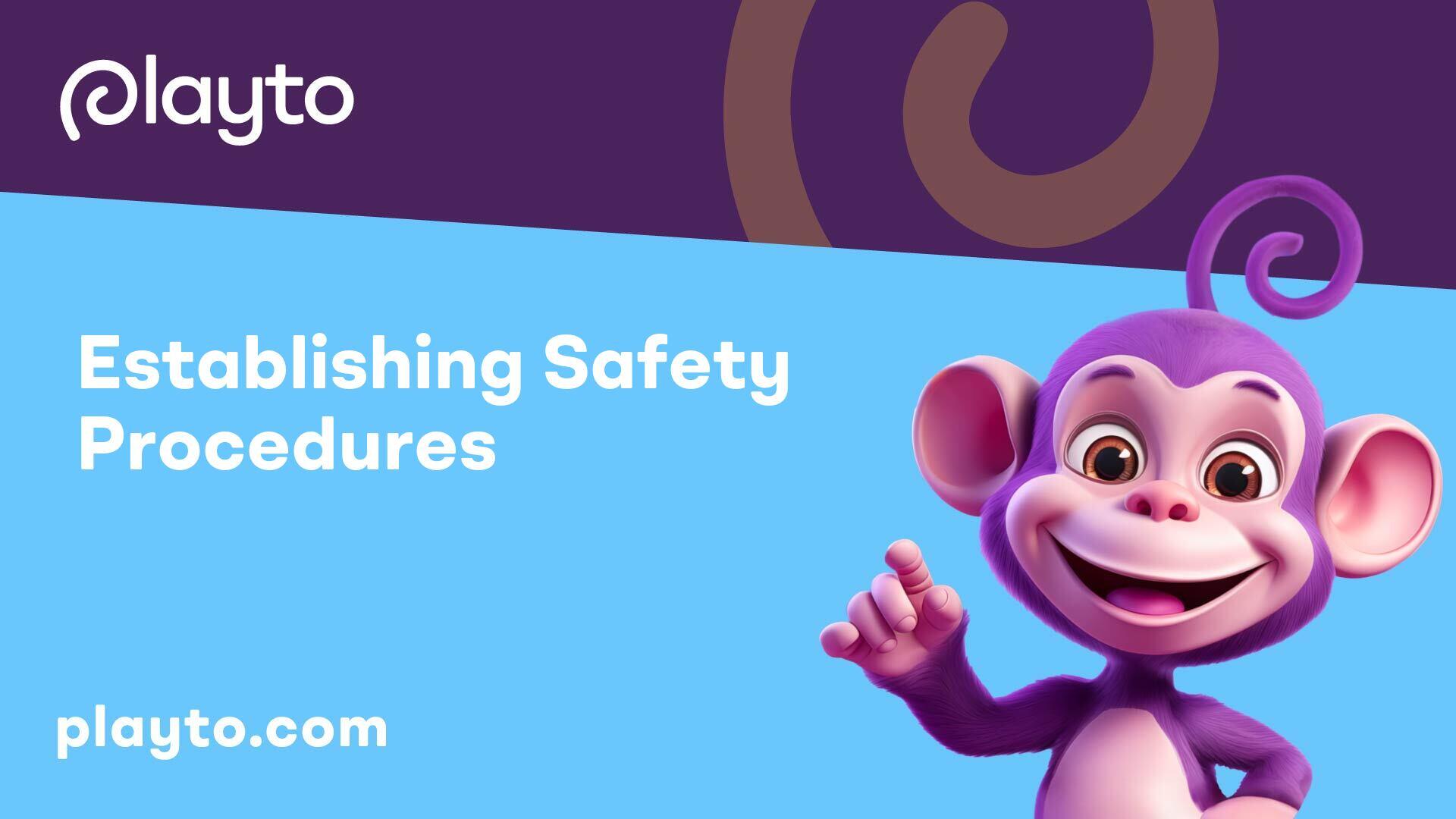
Establishing Safety Procedures
Ensuring a safe environment for children in daycare centers involves the implementation of comprehensive safety procedures. Two key aspects of this process are conducting regular safety inspections and implementing advanced security equipment.
Conducting Regular Safety Inspections
To maintain high safety standards, it is essential for child care centers to conduct regular safety inspections as noted by Procare Software. These inspections involve monitoring various factors including staff training, facilities, equipment, and procedures. Safety checklists can aid in comparing safety practices to the latest standards, ensuring that the center is up-to-date with safety regulations.
Implementing Advanced Security Equipment
Child care centers can enhance safety measures by utilizing cutting-edge security equipment and features, such as keyless entry systems, interior door controls, biometric check-in scanners, and real-time contactless pickup/drop-off records [1]. By employing a child care app to track student attendance and monitor staff-child ratios, centers can increase security and streamline administrative processes.
Advanced security equipment not only enhances the overall safety of the daycare facility but also provides peace of mind to parents and staff members. Incorporating these technologies can improve efficiency in monitoring and managing security measures, ultimately creating a secure environment for children to learn and play.
By conducting regular safety inspections and incorporating advanced security equipment, daycare centers demonstrate a commitment to the safety and well-being of the children under their care. These measures not only safeguard the children but also contribute to building trust and confidence among parents and staff regarding the center's safety protocols.

Field Trip Planning
When it comes to ensuring the safety of children during daycare field trips, meticulous planning is essential. This section focuses on the critical components of field trip planning, including communication with parents, selection of age-appropriate activities, and coordination of transportation logistics.
Communication with Parents
Effective communication with parents is key to a successful and safe daycare field trip experience. Parents should be kept informed of every stop, activity, and detail involving their child during the field trip. Providing parents with a detailed itinerary and obtaining signed consent forms not only ensures transparency but also offers peace of mind for both organizers and parents.
It is vital to establish clear channels of communication with parents throughout the planning process, addressing any concerns they may have, sharing emergency contact information, and outlining the protocols in place to ensure their child's safety.
Age-Appropriate Activities
When organizing daycare field trips, organizers must carefully consider the age appropriateness of the activities planned. Participants should only engage in activities that are suitable for their developmental stage. Choosing activities that align with the children's cognitive and physical abilities is crucial to ensuring a safe and enjoyable experience for all involved.
Moreover, adults accompanying the children on the field trip should be knowledgeable about age-appropriate interactions and interventions in case of any issues that may arise during the activities [2].
Transportation Logistics
Proper planning of transportation logistics is paramount to the safety of children during field trips. Organizers should arrange for safe and reliable transportation, such as buses or vehicles driven by trusted adults, to ensure that all children reach their destination securely.
Maintaining an accurate roster to count children at various checkpoints throughout the trip is essential. Conducting headcounts before departing from the daycare, upon boarding and disembarking from the vehicle, and at the destination is crucial to ensure that all children are supervised and accounted for at all times.
Children should be taught safe travel skills, whether walking near traffic or riding in a vehicle during field trips. It is essential to follow pedestrian safety rules, utilize appropriate child-safety restraints in vehicles, monitor children closely in public spaces, and reinforce safety guidelines throughout the trip to minimize risks and enhance overall safety.
By prioritizing clear communication with parents, selecting age-appropriate activities, and coordinating transportation logistics effectively, daycare providers can ensure the safety and well-being of children during field trips.

Staff Training and Preparedness
When it comes to ensuring the safety of children during daycare field trips, staff training and preparedness are of paramount importance. Here we will delve into the key areas of focus for staff training: hazard identification, emergency response training, and allergy awareness.
Hazard Identification
Staff members leading the field trip should undergo comprehensive training in hazard identification to ensure a proactive approach to minimizing risks. By being able to recognize potential hazards in various environments, daycare staff can preemptively address safety concerns and create a secure environment for children during outings.
It is essential for staff members to conduct thorough assessments of field trip locations, including transportation vehicles, activity areas, and facilities, to identify any potential hazards such as uneven terrain, trip hazards, or dangerous wildlife. By staying vigilant and observant, staff can take appropriate measures to mitigate risks and prioritize the safety of all children under their care.
Emergency Response Training
In the event of unforeseen emergencies during field trips, daycare staff must be equipped with the necessary skills and knowledge to respond swiftly and effectively. Training in emergency response protocols, including evacuation procedures, first aid administration, and communication strategies, is vital in ensuring the well-being of children in high-pressure situations.
All daycare staff members should receive training in CPR and first aid to handle medical emergencies with confidence and competence. Additionally, drills and simulations can help staff practice their response to emergencies, ensuring a coordinated and efficient approach when faced with real-life scenarios.
Allergy Awareness
Allergies are a common concern among children, and daycare staff must be well-versed in allergy awareness to provide a safe environment for all attendees. Staff training should include education on common allergens, recognizing allergic reactions, and the proper administration of medications such as epinephrine in case of severe allergic responses.
Moreover, staff members should be familiar with the specific allergies and dietary restrictions of each child under their care, ensuring that appropriate precautions are taken to prevent exposure to allergens. Clear communication with parents regarding allergies and emergency action plans is essential to guarantee a swift and effective response in case of an allergic reaction.
By prioritizing hazard identification, emergency response training, and allergy awareness in staff training programs, daycares can enhance their safety policies during field trips and uphold a high standard of care for the children in their charge. For more insights into daycare safety measures, explore our article on safety measures for multi-age daycare classrooms.

Written Safety Policies
Ensuring a safe environment for children in daycare facilities involves the development and dissemination of comprehensive safety policies. These written guidelines not only serve as a framework for daycare safety policies during field trips but also enhance transparency, accessibility, and preparedness.
Transparency and Accessibility
Written policies for safety, security, and health should be meticulously formulated and made available to everyone associated with the daycare, particularly staff and parents. These policies play a pivotal role in establishing clear expectations and procedures in case of emergencies. To promote transparency and readiness for potential audits, it is recommended to provide these policies online through a parent portal or upon request through a form on the website. This accessibility ensures that all stakeholders are well-informed and aligned with the daycare's safety protocols.
Importance of Background Checks
Background checks are a fundamental component of ensuring a safe environment in childcare facilities. Conducting thorough background checks when hiring new staff is paramount in safeguarding children under the facility's care. Additionally, maintaining a consistent environment with low turnover is crucial for children to build strong connections with their caregivers and teachers. Background checks serve as a preventive measure to identify any red flags and maintain a secure environment for all individuals involved [4].
Training in CPR and First Aid
In a daycare setting, emergencies can arise swiftly, necessitating prompt and effective response. It is highly recommended that at least one staff member, if not all, on duty each day should possess training and ongoing education in pediatric CPR and first aid. This training equips staff members with the necessary skills to handle various emergency situations involving children at the daycare facility. By fostering a culture of preparedness through regular training and education, daycares can enhance their capacity to respond swiftly and effectively in times of need [4].
By incorporating these elements into written safety policies, daycares can establish a robust framework that prioritizes safety, transparency, and preparedness in all aspects of their operations.

Childproofing Measures
Ensuring the safety of children in a daycare setting involves comprehensive childproofing measures. These measures encompass both indoor hazard elimination and outdoor safety practices to create a secure environment for young ones.
Indoor Hazard Elimination
Childproofing indoors involves meticulous attention to detail to identify and eliminate potential hazards that could pose a risk to children. It is essential to conduct regular safety inspections to assess any dangers and take appropriate measures to address them. Hazards such as sharp objects, small items that could be a choking hazard, and unstable furniture should be removed or secured out of reach of children.
Furthermore, ensuring that electrical outlets are covered, cabinets containing cleaning supplies are locked, and ensuring windows have proper locks or guards are all crucial steps in maintaining a safe indoor environment for children. Regular safety inspections and staff training on hazard identification are instrumental in maintaining a safe indoor space for children.
Outdoor Safety Practices
Outdoor play areas offer children opportunities for physical activity and exploration. To ensure their safety, it is vital to establish and maintain outdoor safety practices. Educating children on using equipment properly, watching out for others, and adhering to playground rules are essential components of outdoor safety practices.
Careful inspection of outdoor equipment and toys for safety concerns before children use them is crucial. Regular maintenance and checks of the playground area, including ensuring the ground surface is suitable for safe play, can help prevent accidents and injuries. Supervision by trained staff is key to maintaining a safe outdoor environment for children to play and learn.
By implementing rigorous indoor hazard elimination measures and promoting outdoor safety practices, daycare facilities can create a secure and nurturing environment for young children. These childproofing measures, when combined with appropriate supervision protocols, play a pivotal role in ensuring the well-being and safety of children in daycare settings.
Supervision Protocols
Ensuring child safety during field trips requires meticulous attention to detail and effective supervision protocols. Within the daycare setting, specific measures are put in place to oversee bathroom and diaper changing safety, maintain accurate child rosters and conduct headcounts, as well as teach children safe travel skills.
Bathroom and Diaper Changing Safety
In daycare environments, the safety and privacy of children during bathroom visits and diaper changes are paramount. Supervising adults should follow strict protocols to ensure the well-being of each child. This includes maintaining a clean and organized diaper changing area, using disposable gloves when changing diapers, and properly disposing of soiled diapers in a hygienic manner.
Moreover, frequent handwashing practices are essential to prevent the spread of germs and maintain a healthy environment for all children. By adhering to strict bathroom and diaper changing safety guidelines, daycare staff can uphold high standards of cleanliness and minimize potential health risks.
Child Roster and Headcounts
Before embarking on any field trip, daycare staff must establish a comprehensive child roster and conduct headcounts at various checkpoints to account for all children under their care. According to Virtual Lab School, these headcounts should occur before departing from the daycare center, upon entering and exiting the vehicle (if applicable), upon arrival at the destination, and intermittently throughout the trip.
Assigning specific groups of children to each supervising adult can facilitate efficient monitoring and ensure that every child receives adequate attention and care. By maintaining a meticulous child roster and conducting regular headcounts, daycare staff can guarantee the safety and well-being of all children during field trips.
Safe Travel Skills
Teaching children safe travel skills is another crucial aspect of supervision protocols in daycare settings. Children should be educated on essential safety practices, such as holding hands when crossing the street, staying with the group at all times, and following instructions from supervising adults.
Additionally, daycare staff should emphasize the importance of wearing seat belts and remaining seated during vehicle transportation to prevent accidents and ensure a secure traveling experience. By instilling safe travel skills in children from a young age, daycare centers can promote a culture of safety and responsibility during field trips.
By prioritizing bathroom and diaper changing safety, maintaining accurate child rosters and conducting headcounts, and teaching children safe travel skills, daycare facilities can uphold comprehensive supervision protocols that prioritize the well-being and security of all children during field trips.
Identification and Communication
In a daycare setting, ensuring clear identification and effective communication are essential components of daycare safety policies during field trips. By utilizing strategies that focus on quick identification and maintaining open communication channels with parents, daycares can enhance the safety and organization of off-site excursions.
Matching Attire for Quick Identification
To facilitate quick identification of children and staff during field trips, it is advisable to provide them with matching T-shirts or hats to wear. This uniform approach enhances the group's visibility and cohesiveness, making it easier to spot and manage individuals effectively in crowded or unfamiliar environments [3]. Additionally, using stickers with contact information can further aid in identifying children in the group.
Parent Communication Strategies
Effective communication with parents is paramount when it comes to field trips. Parents should be informed and reminded of the upcoming trip a day before to ensure they are prepared and aware of the itinerary. On the day of the excursion, posting a sign on the classroom door detailing the destination and expected return time helps keep parents informed about their child's whereabouts and activities. Transparent and proactive communication strategies not only instill confidence in parents but also foster a strong sense of community within the daycare program.
By incorporating these strategies into daycare safety policies, daycares can promote a safe and organized environment during field trips, reassuring both parents and staff of the children's well-being and security throughout the outing.
Emergency Preparedness
In the realm of daycare safety policies during field trips, emergency preparedness is paramount to ensuring the well-being of children. Two critical components of emergency preparedness in daycare settings are regular safety drills and maintaining appropriate staff-to-child ratios.
Regular Safety Drills
Daycare centers should conduct regular safety drills to familiarize both staff and children with emergency procedures and responses. These drills encompass various scenarios like fire, tornado, lockdowns, and earthquakes. By practicing these drills consistently, daycare centers can ensure that all individuals know their roles and responsibilities in case of an emergency. Regular safety drills help to instill a sense of preparedness and ensure that quick and efficient actions can be taken when needed.
Staff-to-Child Ratios
Maintaining appropriate staff-to-child ratios is essential for creating a safe and secure environment in daycare centers, especially during field trips. Dr. Cassie Hudson recommends having more adults compared to babies in each room to enhance safety levels. As children age, the ratio can be adjusted accordingly; however, it is crucial to adhere to state-mandated criteria regarding staff ratios. Adequate supervision ensures that every child receives the attention and care they require, reducing the risk of accidents or incidents [5].
By prioritizing regular safety drills and ensuring optimal staff-to-child ratios, daycare centers can fortify their emergency preparedness protocols and effectively safeguard the children under their care. These measures contribute significantly to the overall safety and security of daycare operations during field trips and everyday activities.
Field Trip Policies
When it comes to ensuring the safety of children during daycare field trips, having comprehensive policies in place is paramount. Child release guidelines, vehicle safety regulations, and documentation retention are key aspects that daycare centers in New York need to consider to maintain a secure environment for the children.
Child Release Guidelines
Child release policies in daycare centers play a crucial role in ensuring the security and well-being of each child. These guidelines involve authorization procedures and absence protocols to guarantee that children are released only to authorized individuals with written permission from parents or guardians. It is imperative for daycare staff to verify the identity of individuals picking up the child and to have clear protocols in place for situations where a child's designated guardian is unavailable. By implementing strict child release guidelines, daycare centers can uphold their commitment to child safety and security.
Vehicle Safety Regulations
Daycare centers are required to have stringent vehicle safety regulations in place for field trips. This includes regular inspections of vehicles by staff members or certified mechanics to ensure compliance with safety standards. Detailed documentation of these inspections is necessary to track the maintenance history of the vehicles and demonstrate adherence to safety protocols. By closely monitoring the condition of vehicles used for transportation, daycare centers can minimize the risk of accidents and prioritize the safety of the children in their care [6].
Documentation Retention
Proper documentation retention is essential for maintaining a record of all safety-related activities and incidents during field trips. Daycare centers must retain documentation related to vehicle inspections, child release procedures, and emergency responses. These records serve as a vital reference point for evaluating safety protocols, identifying areas for improvement, and demonstrating compliance with regulatory requirements. By consistently documenting safety-related information, daycare centers can enhance their accountability and ensure the ongoing safety of the children under their supervision.
Incorporating child release guidelines, vehicle safety regulations, and documentation retention protocols into field trip policies is essential for promoting a culture of safety and security within daycare centers. By establishing clear procedures and adhering to stringent safety standards, daycare centers in New York can prioritize the well-being of the children in their care and provide parents with peace of mind knowing that their children are in safe hands.
References
[1]: https://www.procaresoftware.com/blog/indoor-and-outdoor-safety-checklist-for-child-care-centers/
[2]: https://www.jackrabbitcare.com/blog/how-to-ensure-safety-on-field-trips
[3]: https://www.virtuallabschool.org/preschool/safe-environments/
[4]: https://info.ezchildtrack.com/blog/how-to-improve-safety-in-your-daycare-program
[5]: https://www.care.com/c/10-signs-of-a-safe-day-care/
[6]: https://www.playto.com/blog/daycare-policies-on-field-trip-permissions
